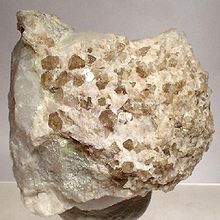| Zunyite | |
|---|---|
 Sharp, pyramids of brown-red zunyite from Silver City, Tintic District, East Tintic Mountains, Juab County, Utah, US (size: 5.5 x 5 x 3.5 cm) Sharp, pyramids of brown-red zunyite from Silver City, Tintic District, East Tintic Mountains, Juab County, Utah, US (size: 5.5 x 5 x 3.5 cm) | |
| General | |
| Category | Sorosilicates |
| Formula (repeating unit) | Al13Si5O20(OH,F)18Cl |
| IMA symbol | Znu |
| Strunz classification | 9.BJ.55 |
| Crystal system | Isometric |
| Crystal class | Hextetrahedral (43m) H-M symbol: (43m) |
| Space group | F43m |
| Unit cell | a = 13.8654 - 13.8882 Å; Z = 4 |
| Identification | |
| Color | Grayish white, flesh-red; colorless in thin section |
| Crystal habit | Crystalline - occurs as well-formed fine sized crystals |
| Twinning | On {111}, contact and penetration |
| Cleavage | Good on {111} |
| Fracture | Uneven |
| Tenacity | Brittle |
| Mohs scale hardness | 7 |
| Luster | Vitreous |
| Streak | White |
| Diaphaneity | Transparent to translucent with inclusions |
| Specific gravity | 2.874(5) (meas.) 2.87 - 2.90 (calc.) |
| Optical properties | Isotropic |
| Refractive index | n = 1.592 - 1.600 |
| Other characteristics | May fluoresce red under UV |
| References | |
Zunyite is a sorosilicate mineral, Al13Si5O20(OH,F)18Cl, composed of aluminium, silicon, hydrogen, chlorine, oxygen, and fluorine.
Occurrence

Zunyite occurs in highly aluminous shales and hydrothermally altered volcanic rocks. It occurs in association with pyrophyllite, kaolinite, alunite, diaspore, rutile, pyrite, hematite and quartz.
It was discovered in 1884, and named for its discovery site, the Zuni mine in the Silverton District, San Juan County, Colorado.
References
- Warr, L.N. (2021). "IMA–CNMNC approved mineral symbols". Mineralogical Magazine. 85 (3): 291–320. Bibcode:2021MinM...85..291W. doi:10.1180/mgm.2021.43. S2CID 235729616.
- ^ Handbook of Mineralogy
- ^ Mindat.org
- Web Mineral
- Glendale Community College; retrieved March 26, 2005.
- Euromin; retrieved March 26, 2005.
This article about a specific silicate mineral is a stub. You can help Misplaced Pages by expanding it. |